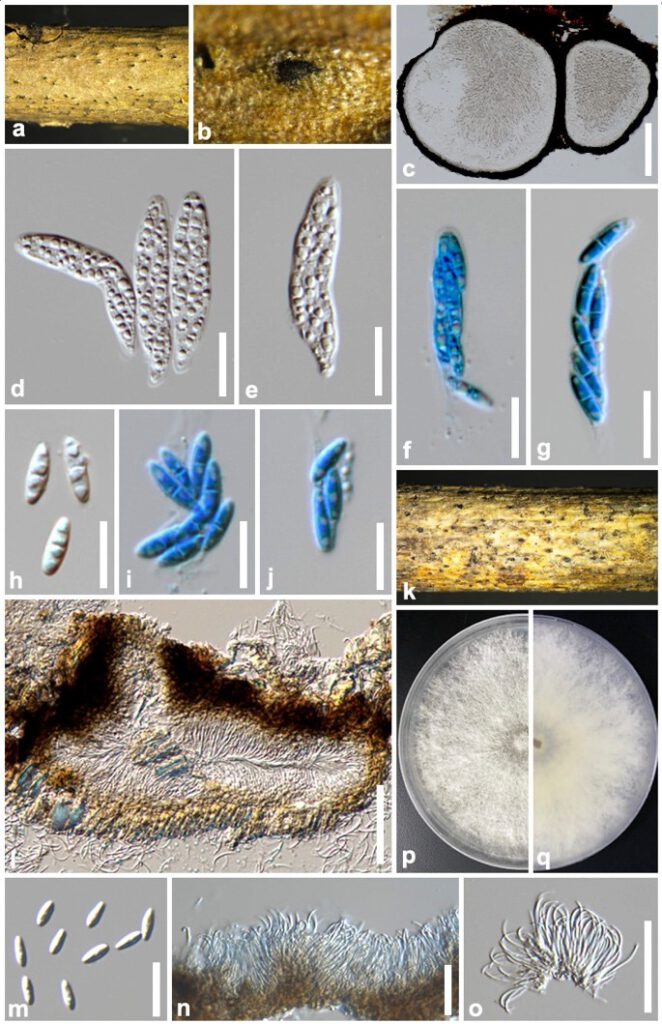Diaporthe cavata Y.Y. Chen, A.J. Dissanayake and Jian K. Liu sp. nov. (Figure a)
MycoBank number: MB; Index Fungorum number: IF; Facesoffungi number: FoF 12612.
Etymology: Refers to the feature of the ascomata (hollow inside after maturing).
Holotype: GZAAS 19-1932
Saprobic on decaying wood. Sexual morph: Ascomata 200–350 μm diam., black, globose to irregular, clustered and scattered on dead twigs, immersed in host tissue, protruding through substrata. Asci (60–)63–68(–69) × (9–)10–18(–19) μm, 8-spored, unitunicate, sessile, elongate to clavate. Ascospores (11–)12–14(–15) × (3–)3.5–4(–5) μm ( = 13 × 3.6, n = 30), hyaline, 2-celled, often tetra-guttulate, with larger guttules at centre and smaller at ends, elongated to clavate. Asexual morph: Conidiomata 200–350 μm diam., globose to irregular, erumpent at maturity. Peridium up to 60–150 μm diam., parenchymatous, consisting of 3–4 layers of medium brown textura angularis. Conidiophores 20–45 × 2–2.4 μm, cylindrical, hyaline, smooth, branched, ampulliform, straight to sinuous. Conidiogenous cells up to 0.5–1 μm, phialidic, cylindrical, terminal, with slight tapering towards apex. Paraphyses 20–40 × 1–2 μm, abundant among conidiophores. Alpha conidia (6–)7–8(–9) × 2–3.5 μm ( = 7.5 × 3, n = 30), aseptate, hyaline, smooth, ovate to ellipsoidal, biguttulate, base subtruncate. Beta conidia (22–)27–31(–35) × (3–)3.5–4(–4.5) μm ( = 29 × 4, n = 30), aseptate, hyaline, smooth, fusiform or hooked, base subtruncate.
Culture characteristics: Colonies covering entire PDA Petri dishes after 10 d at 25 °C producing abundant white aerial mycelium. Reverse white, turning to grey in centre.
Material examined: China, Guizhou Province, Chishui city, saprobic on decaying woody host, March 2021, Y. Y. Chen (GZAAS 19-1932, holotype); ex-type living culture CGMCC = GZCC 19-0213; ibid, Guiyang District, saprobic on decaying woody host, July 2020, Y. Y. Chen (GZAAS 22-0012, paratype), living culture GZCC 22-0011.
Notes: The phylogenetic results showed that Diaporthe cavata clustered closer to D. pterocarpicola forming a distinct lineage (Figure 2) with maximum support (ML/MP/BI = 100/100/1.0). Diaporthe cavata can be distinguished from D. pterocarpicola in the concatenated alignment by 11/512 in ITS, 27/413 in tef, 8/453 in tub and 11/506 in cal while the his gene region is unavailable for the latter species. Morphologically, D. pterocarpicola differs from D. cavata in having slightly elongated black necks (Udayanga et al. 2012). As D. pterocarpicola has no reported sexual morph, we were unable to compare the morphological features of the sexual morph.

Figure a. Diaporthe cavata (GZAAS 19-1932, holotype). a, b Ascomata on host surface. c Section of ascomata. d, e Asci. f, g Asci stained in methylene blue. h Ascospores. i, j Ascospores stained in methylene blue. k Conidiomata on host surface. l Section of conidiomata. m Alpha conidia. n, o Beta conidia attached to conidiophores. p 10 days old culture on PDA from above. q 10 days old culture on PDA from reverse. Scale bars: c = 100 μm; d–g = 20 μm; h–j = 10 μm; l = 100 μm, m = 10 μm; n, o = 40 μm.
